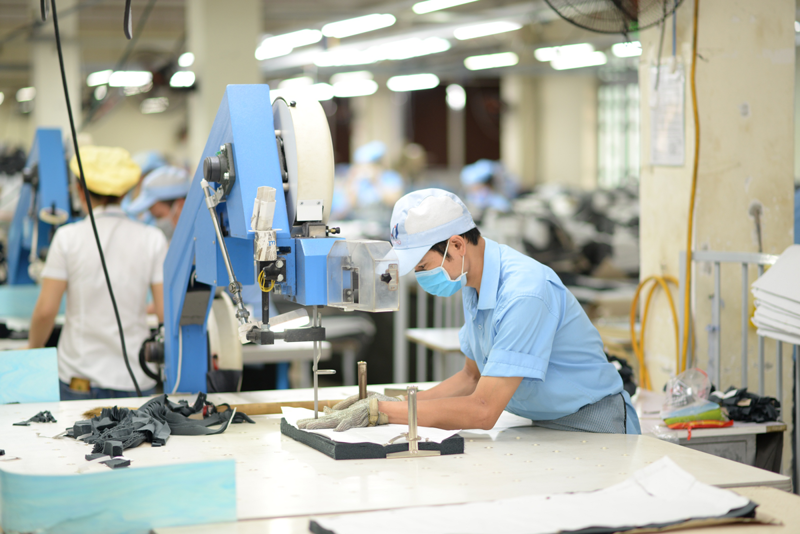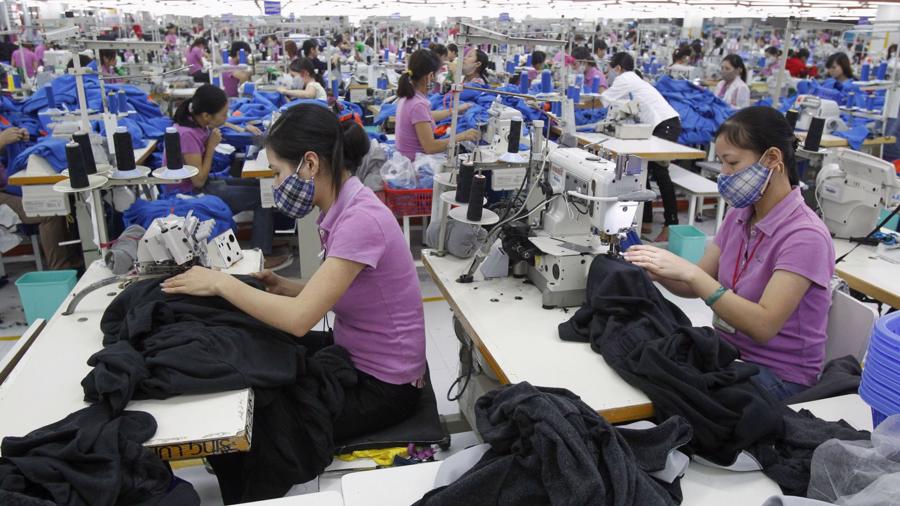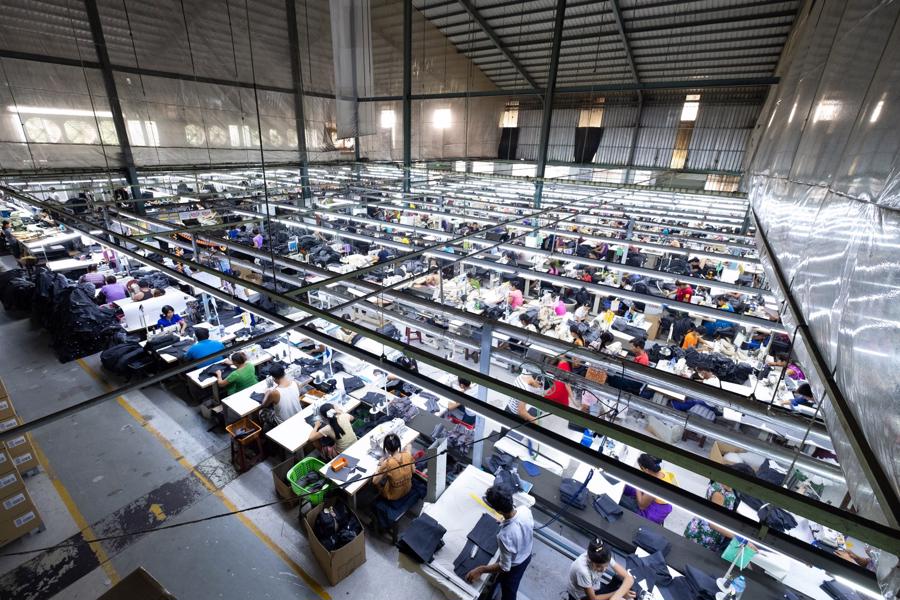
Illustration.
In the first six months of this year, textile and garment export turnover reached US$22.3 billion, up 23% over the same period last year. This is considered a positive result of the textile industry. However, the situation in the last 6 months of the year was not so positive.
Although orders were many, prices were not as good as every year as consumers in major export markets began to tighten their spending because of inflation concerns. In addition, textile and garment enterprises are also facing the problem of lack of raw materials, labor and increased costs due to escalating gasoline prices... leading to a situation where they have to calculate and balance costs to maintain maintain production.
RISK OF REDUCTION OR STOP OF ORDER
Previously, Factory 8 Cam Thuy Branch, Ho Guom Group, signed an average of each contract with a partner from the United States with orders to sew up to 300,000-400,000 children's fashion pants. Although this is a strong product of the company, from the second quarter of this year, the number of orders was less than 200,000 units, equal to 20% of the company's total export volume. “It is not expected that from now until the end of the year nothing will be positive. Usually in the past, the partners were always eager to get the goods, and the goods they produced were always there, but until now they are very indifferent because there is no demand”, said Mr. Khuong Van Tai, Director of 8 Chi Enterprises. Cam Thuy branch, Ho Guom Group is worried.
Attending a conference on sustainable cotton supply chain held at the end of June, Mr. Than Duc Viet, General Director of Garment 10 Corporation, said that although the company had orders until the end of the third quarter and some Strong products such as shirts and vests have orders until the end of 2022, but if the consumption market is slow, the inventory ratio of importers increases, customers can adjust down or cancel orders suddenly. With the production chain, the cost of raw materials and fuel increases, causing production costs to increase, the profit margin of enterprises is increasingly narrowing.
This is also a concern of Thanh Cong Textile - Investment - Trade Joint Stock Company. Tran Nhu Tung, Chairman of the Company, said that the demand for textiles and garments in the fourth quarter may slow down because the US started applying the Uighur Forced Labor Prevention Act (UFLPA) from 21/02. 6, causing brands to slow down in placing orders. “They didn't know what was going to happen in the future, so the order situation was also reduced. For example, before they could order 100,000 products, now they only order about 70,000 products for fear of not being able to sell," said Tung.

Orders were shortened due to high inventories in the export market and tight spending by people.
Mr. Nguyen Van Thoi, Chairman of the Board of Directors of TNG Investment and Trading Joint Stock Company (TNG), acknowledged that inflation and the Fed's interest rate hike may affect purchasing power in the US and EU markets. These are the two main export markets of Vietnam. "The textile and garment industry has set a target to export 43-44 billion USD this year, but I think the whole industry may not reach the target but still grow by 5% over the same period last year," Thoi said. .
The Chairman of TNG said that from August to December, there will be a clear differentiation of the capacity of enterprises. Good, reputable businesses will receive many orders, while small and medium enterprises with low reputation will have a lower number of orders.
As reflected by domestic garment manufacturing companies, if in the past, customers usually ordered 6 months in advance, now they only order 3 months in advance, the order is shortened due to the amount of inventory in the market. Exports are high and people are tightening their spending.
Explaining this situation, a representative of the Vietnam Textile and Apparel Association said that most of the inventories of European and American partners are essential clothing during the outbreak of Covid-19 when people are limited. out, now this amount has accumulated. In addition, the need to switch to work clothes, travel, and outdoor activities makes businesses lose time handling inventory.
Chairman of the Vietnam Textile and Apparel Association Vu Duc Giang predicted that in the second half of 2022, the world market will have many unpredictable changes, posing many challenges for businesses and the export target of the entire textile and garment industry. The strong inflation situation in the US and Europe, causing food prices to skyrocket, will make the purchasing power of consumer goods, including textiles, reduce significantly. This will affect business orders in the third and fourth quarters.
Efforts to find a solution
Along with inflationary pressure, the Russia-Ukraine war has not ended while gasoline prices and shipping costs continuously increase, causing production costs of enterprises to rise, prices of raw materials have increased by nearly 30 % compared to before are the challenges that Vietnamese textile and garment enterprises are facing. This negatively impacts the entire textile supply chain, from manufacturer to retailer. Gross profit margin of domestic manufacturing companies continued to shrink.
Facing the above challenges, domestic textile and garment enterprises are trying to find solutions. A representative of the Vietnam Textile and Apparel Association said that the goal of achieving an export turnover of 43 - 43.5 billion USD in 2022 is still possible to achieve if businesses receive timely support. Therefore, the representative of the Vietnam Textile and Apparel Association suggested: related to trade with Russian partners, businesses are confused, even some enterprises have produced but cannot deliver goods; The authorities should have recommendations or orientations for businesses, especially how to ensure the safety of goods.
In addition, businesses believe that it is necessary to always change and diversify the supply of domestic materials and accessories to be proactive in delivery time and save transportation costs; at the same time, regularly negotiate, look for new customers and orders in order to maintain regular production and stable jobs for employees. "Vietnamese businesses will have to find orders in other markets to fill the gap left by American brands," suggested Mr. Vu Duc Giang.

The situation of strong inflation causing food prices to skyrocket will cause the purchasing power of consumer goods, including textiles, to decrease significantly.
On the business side, to cope with these difficulties, each unit is actively monitoring market developments to promptly adjust production plans to suit reality. For example, Garment 10 Corporation is focusing on order management and production planning in line with market fluctuations. “In the past, we used to do it quarterly, monthly, now we have to do it daily and weekly. This is imperative for businesses to be flexible because of fluctuations in politics, commodity prices and input material prices,” said Mr. Than Duc Viet.
In addition to "greening" the production process to meet the requirements of fastidious markets, experts also say that in order to maintain double-digit export growth, textile and garment enterprises need to find new partners. right in the traditional market, with typical products with high export value.
In the long term, the response of the garment industry is to prioritize measures to keep labor stable, flexibly change products, coordinate or cut production time, and ensure enough jobs for workers in the long run. waiting time for new orders.
Luu Ha
https://vneconomy.vn/don-hang-du-nhieu-doanh-nghiep-det-may-van-lo.htm
vneconomy